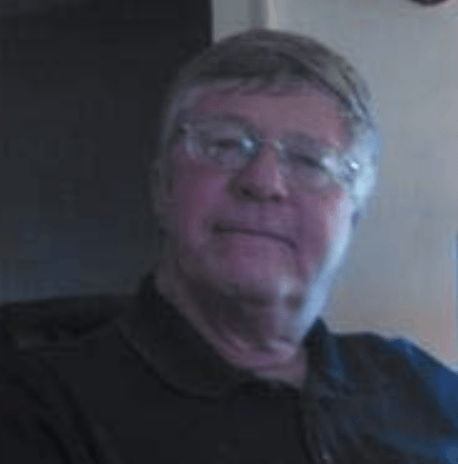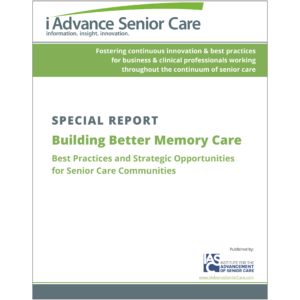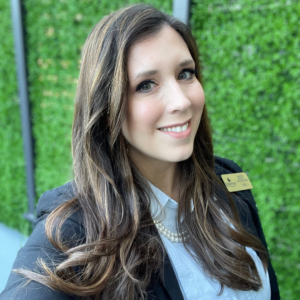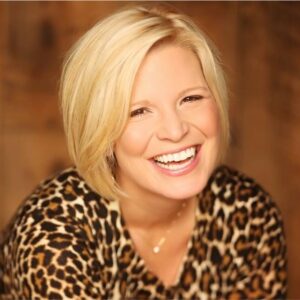‘Use it or lose it’: The Brain Health Program at Emeritus Assisted Living
The brain works like a muscle—use it or lose it. That saying is gaining increasing credibility in the field of aging studies. For decades, of course, the standard take on geriatric cognition was that the elderly person had long since maxed out on brain cells and had been losing these in steady decline for decades. Cognitive decline, whether Alzheimer's-related or not, was the aging individual's inexorable fate. Recent years have seen a dramatic turnaround in such conceptualizing, at least in scientific circles. Evidence has accumulated from carefully controlled studies that many factors—physical, mental, social, spiritual, and dietary—can impact positively on brain function throughout life, regardless of age. Recently, the 14-year-old senior care chain Emeritus Assisted Living, with more than 200 communities in 38 states, decided to put brain health programming into action, in partnership with one of its leading scientific proponents, Paul Nussbaum, PhD, adjunct associate professor of Neurological Surgery at the University of Pittsburgh School of Medicine. The brain health program is rolling out as a pilot project in three Emeritus facilities and real-world results are being monitored. Recently, several key staffers involved in the pilot, along with Dr. Nussbaum, discussed how this approach stands to impact their company and long-term care in general, in a roundtable moderated by Nursing Homes/Long Term Care Management Editor-in-Chief Richard L. Peck.
Participants
Adora Brouillard, Director of Education and Training
Chris Guay, Northeast Divisional Director of Operations
Andrea Hunter, Executive Director, Anderson Place, Anderson, South Carolina
John Madden, Executive Director, Stanford Center, Altamonte Springs, Florida
Dee McGinnis, National Director of Wellness
Paul Nussbaum, PhD, Associate Professor of Neurological Surgery, University of Pittsburgh School of Medicine
Kelly Scott, Director of Training and Special Care Program, East Operations
Roundtable
Peck: How did the brain health program get started at Emeritus?
Chris Guay: Senior Vice-President Gary Becker saw Dr. Nussbaum speak about three years ago and was highly impressed. We are always seeking to improve our resident care, and Mr. Becker saw a way we might do better with residents who have dementia, and even help those without dementia maintain their wellness. Dr. Nussbaum was interested in partnering with us and before long a number of us in management were involved in taking this to another level.
We know that this is not a pill or a computer program—it is a lifestyle change to maintain brain wellness. The five critical components of brain health involve physical exercise, mental stimulation, social connection, spirituality, and appropriate nutrition. We’ve piloted this program in three facilities, using principally a three-pronged approach: educating our residents and families about the benefits of brain health; getting employees involved in maintaining their own brain health and becoming “ambassadors” for this; and opening this education to the surrounding community so as to be seen as a “brain health” resource center. We are trying to create a culture in Emeritus facilities that will benefit everyone who comes in contact with our organization.
Peck: How did you specifically implement this in the individual facilities?
Kelly Scott: Dr. Nussbaum met with every department head and manager involved to educate and guide them. Among the things we're doing is helping encourage consumption of brain-healthy foods and snacks by identifying them with specially designed brain-health logos on the menus that we post for residents every day. We're also encouraging employee involvement by having them wear pedometers and attempt to walk at least 10,000 steps (about five miles) a day; we have people competing on this now, and one maintenance director impressed everyone recently by doing 50,000 steps in one day! We're also offering stimulating activities, such as board games, word games, trivia, storytelling, and dance (which is highly popular), as well as regular church services.
Dr. Paul Nussbaum: It's important to note that all of this is research-based. Research shows, for example, the health benefit of daily prayer, attending church services, doing breathing exercises, slowing down, and saying “no” to stress. There is established benefit in having at least one sit-down meal a day, preferably with relative “strangers” in a novel and complex environment, the best situation for brain health. It's been shown that stimulating, though not overstimulating, the hippocampus of the brain leads to new cellular connections in that area of the brain and protection against Alzheimer's disease. For example, playing board games, traveling, reading and writing daily, or learning a second language can have this protective effect. We’ve seen that physical activity, such as dance or walking three hours a week, actually causes beneficial structural change in the brain. Socialization—joining clubs and organizations, developing one's hidden talents—avoids the isolation that poses risk of Alzheimer's. With nutrition, we know that the brain is 60% fat, and so it makes sense that fatty fish consumption is brain healthy, as are intake of antioxidants and vitamins A, B, C, and E. Dietitians know that a healthy plate should look like a rainbow, with fruits and vegetables of many colors, and that snacks like bowls of walnuts or red grapes can be helpful, as can a glass of red wine or red grape juice each day.
Peck: What are some of the operational challenges of incorporating some of these ideas in managing a facility?
Andrea Hunter: A lot seems to depend on cognitive capability. Anderson Place offers three levels of care, and we’ve found greatest acceptance so far at the independent level, where residents have greater cognitive capability. In fact, these residents have taken the idea and run with it. They're very involved with the dietary and activities components, and often bring in magazine clippings on brain health for staff to read!
John Madden: As for the more cognitively impaired, we bring the ideas and activities to them. And they don't see this as an imposition or chore—for example, with dancing or card games, if you bring these activities to them so that they have a direct experience of them, those memories do come back and they have fun.
Hunter: In our SNF recently we celebrated Elvis's birthday, and the feeling was contagious—people were up and dancing or watching the dancing and having a good time within a matter of minutes.
Dr. Nussbaum: It's true that in advanced Alzheimer's disease, the part of the brain that learns is pretty much gone. But this type of programming would fit in with the earlier stages of the disease and help to slow the decline. You have to modify the programming based on residents’ remaining capacity. For example, you can move toward less cognitive, more hands-on activities, such as dance, knitting, and gardening. Nutritional needs continue at all levels and spirituality still applies—some people can recite the Lord's Prayer and sit quietly at religious services at all stages of the disease.
Peck: What about the idea that people just can't learn or change as they grow older?
Dr. Nussbaum: That was the idea that prevailed until about 1998, when the first studies appeared that showed that the human brain had the same capacities as the rat brain to develop new cells and maintain good function with stimulation. And more and more we're acknowledging examples of creativity in old age.
Peck: Like Picasso, Grandma Moses, various orchestra conductors in their 80s…?
Dr. Nussbaum: Yes, but we are all seeing exemplars of this in our own lives; they're becoming increasingly common.
Guay: At Emeritus, taking care of people in their 70s, 80s, and 90s is what we do, and since listening to Dr. Nussbaum, I’ve been paying more attention to this. I’ve often asked residents 100 years old or more what was the key to their healthy longevity, and it's amazing how these five key principles of brain health all seem to appear one way or another. These residents are living, breathing examples of what we're talking about.
Peck: Aside from eventually monitoring the results of this program scientifically, do any of you have any anecdotal results you could discuss?
Madden: It's early—right now we're monitoring everyone involved in activities and brain-healthy dining and reviewing any care plan changes that might occur with them. I’d say what I see most clearly at this point is an attitude change—people starting to realize they can do more to keep themselves functional and being very positive about it. I’ve seen more lobby conversations about this than they used to engage in.
Guay: It's hard sometimes, when you're working with people in the latter stages of life, to give them hope. But you do see this change in attitude as time goes by with this program. I would also suggest that those of us at Emeritus who have been exposed to this thinking have made changes in our own personal lives to reflect this.
Dr. Nussbaum: In terms of measuring results, we'll have a two-layer approach. We're taking a less formal approach right now—for example, having nurses measure the resident's mental status now and after 90 days and any changes in mood, using scales that I’ve trained them to apply, such as Geriatric Depression and Recognition Memory. We're also looking at such factors as whether family admissions and visits change as this program becomes more known and whether staff turnover declines. It's possible, down the road, that we'll have a formal evaluation by an independent investigator, which would be the ultimate study. We're still considering this.
Peck: In the meantime, what sort of staff training is needed to bring this off properly?
Guay: We're including this in our human resources processes, getting across the idea that we value helping residents help themselves. The next step will involve making brain health an official part of staff orientation and, beyond that, a central part of our corporate culture. We're still in the early stages of much of this.
Dee McGinnis: And we understand that this is culture change, not an edict from the top down. That means doing it slowly to get it right. It's not something we're adding an á la carte service charge for. We're trying to create a sea change for our residents, staff, and families.
Guay: One thing is for sure: We have corporate support for this, and when the corporate office gets jazzed about something, it makes it more acceptable for everyone to get involved. Right now we're identifying the next tier of facilities to get involved with this program, and I know that the ultimate goal is to have every Emeritus community become a Brain Health Center.
Adora Brouillard: Our approach, at the corporate level, is to support ideas and concepts that bubble up from the communities that work really well. We try to take best practices from any of the facilities and try to spread them throughout the organization.
McGinnis: And the other communities don't have to wait to implement brain health programs. Our Oceanside, California, facility, for example, under Kevin Carlin, has already starting rolling this out, even though the facility is not part of the formal pilot.
Dr. Nussbaum: I’ve been trying for 10 or 15 years to get knowledge of the brain on consumers’ and healthcare providers’ radar screens. What's great about Emeritus is that they’ve had the courage to stand up and say that this is worthwhile and worth making a culture change within the company to foster it. To me, even more importantly, Emeritus is contributing to a culture shift in the country. And they will find, as other providers practicing this will find, that people will willingly sign up with places that actively promote their health.
For more information, visit https://www.emeritus.com and https://www.paulnussbaum.com. To send your comments to the editors, see our contacts page.

Richard L. Peck was editor in chief of I Advance Senior Care / Long-Term Living for 18 years. For eight years previous to that, he served as editor of the clinical magazine Geriatrics. He has written extensively on developments in the field of senior care and housing.
Related Articles
Topics: Activities , Articles











